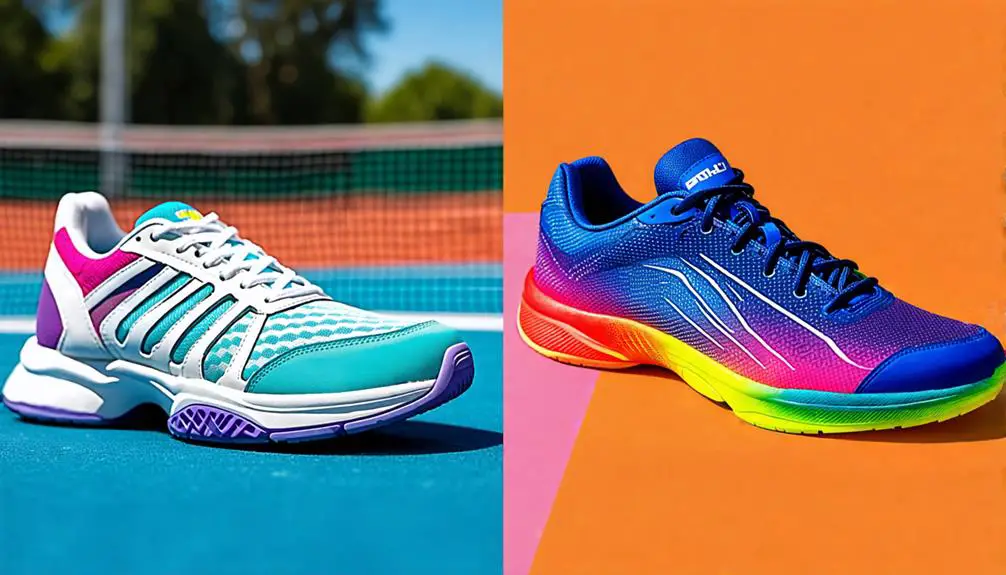Tennis shoes and badminton shoes serve different purposes, so choosing the right pair is essential for your game. Tennis shoes are designed with durable outsoles for outdoor courts, offering more cushioning and support for lateral movements. Badminton shoes, on the other hand, are lighter with non-marking rubber soles ideal for indoor play. They’re built for quick direction changes and better grip, minimizing the risk of slips. If you want to enhance your performance, understanding these differences will help you make an informed choice. Keep exploring to find out more about selecting the best footwear for your sport.
Key Differences in Design
When it comes to the key differences in design between tennis shoes and badminton shoes, you’ll notice several important distinctions. First off, the sole of badminton shoes is typically made from rubber, providing excellent grip on indoor courts. This is vital for quick lateral movements, as you’ll want a shoe that minimizes the risk of slipping and falling. In contrast, tennis shoes often have a more durable outsole designed for outdoor surfaces, which may not offer the same level of traction on indoor courts.
Another significant difference lies in the shoe’s upper construction. Badminton shoes are generally lighter and feature a more breathable design, allowing for better airflow and less heat buildup during intense matches. This can enhance comfort and performance, but it’s also essential for preventing blisters and other foot injuries. On the other hand, tennis shoes are built with more robust materials to withstand the wear and tear of hard court surfaces, which might offer less flexibility but enhances durability.
Additionally, the heel height and overall shape can vary. Badminton shoes tend to have a lower profile, promoting stability during rapid directional changes. This design minimizes the chances of ankle sprains, which can be common in fast-paced games. Tennis shoes, while offering some ankle support, are often designed for a more upright posture, suitable for the forward and backward movements typical in tennis.
Being aware of these differences can help you choose the right footwear for your game, ensuring you prioritize safety and performance.
Cushioning and Support Features
Cushioning and support features play an integral role in the performance and comfort of tennis and badminton shoes. When you’re on the court, you want to guarantee that your feet are well-protected against the impact of quick movements and sudden stops. Tennis shoes typically offer more cushioning, especially in the heel area, which can absorb the shock from lateral movements and powerful serves. This added cushioning helps reduce the risk of injuries, such as stress fractures or sprains.
On the other hand, badminton shoes focus more on providing a lightweight feel and support for quick, vertical movements. They often have targeted cushioning that supports the forefoot and midfoot, which is vital for those rapid jumps and lunges. The design promotes stability, helping to prevent ankle injuries that can occur during fast-paced games.
When choosing between the two, consider your playing style and the specific demands of your sport. If you’re a tennis player who frequently engages in long matches on hard surfaces, you may appreciate the enhanced cushioning in your shoes. Conversely, if you’re into badminton and need agility, opt for shoes that provide the right support and responsiveness.
Ultimately, the right cushioning and support features will not only improve your performance but also enhance your safety on the court. Prioritizing these aspects guarantees you can focus on your game without the distraction of discomfort or risk of injury.
Traction and Grip Comparison
Choosing the right shoes extends beyond just cushioning and support; traction and grip are just as important for your performance on the court. When you’re playing tennis or badminton, you need footwear that allows you to move quickly and safely. Slipping can lead to injuries, which is why you should carefully consider the traction features of your shoes.
Tennis shoes typically have a herringbone or modified tread pattern designed for lateral movements on the court. This design provides excellent grip on various surfaces, including clay, grass, and hard courts. The rubber soles are specifically engineered to guarantee you can pivot, stop, and accelerate without losing your footing. If you’re playing on a hard court, look for shoes with a durability-focused outsole to maintain traction over time.
On the other hand, badminton shoes are tailored for quick, explosive movements and often have a non-marking rubber sole. The grip is optimized for indoor courts, providing excellent traction during rapid direction changes. The soles are generally flatter, which offers a different kind of stability, essential for avoiding slips when lunging or jumping.
Both types of shoes have their strengths, but your choice should depend on the specific demands of your sport. If you prioritize safety and performance, confirm your shoes provide the right level of grip for the surfaces you’ll be playing on. Ultimately, the right traction will enhance your confidence and help prevent injuries, allowing you to focus on your game.
Durability and Material Quality
How can you guarantee your shoes withstand the wear and tear of intense matches? When it comes to both tennis and badminton, the durability and material quality of your footwear is essential. You’ll want shoes that not only support your movements but also hold up against rigorous play. Let’s break down the materials and their impact on longevity.
| Material Type | Durability Level |
|---|---|
| Synthetic Leather | High |
| Mesh Fabric | Moderate |
| Rubber Outsole | Very High |
| EVA Midsole | High |
Synthetic leather offers excellent durability, making it a popular choice for tennis shoes. It can resist abrasions and is less likely to tear during aggressive play. On the other hand, mesh fabric, while breathable, may not withstand the same level of intensity, leading to quicker wear.
The rubber outsole is a key factor in making sure your shoes last longer; it provides grip and resilience, essential for sudden stops and lateral movements. Finally, the EVA midsole adds a level of cushioning, but it’s critical to verify it’s high-quality to prevent it from breaking down too soon.
Choosing the right materials can greatly impact your safety and performance on the court. Investing in well-constructed shoes not only enhances your game but also protects your feet from injuries caused by inadequate support. So, keep durability at the forefront of your footwear selection.
Choosing the Right Footwear
Finding the right footwear for your sport can greatly improve your performance and comfort on the court. When it comes to tennis and badminton, each sport has unique demands that require specific shoe features. Choosing the right pair isn’t just about style; it’s about safety and functionality.
For tennis, you’ll want shoes with a sturdy outsole that provides excellent traction on various surfaces. Look for supportive cushioning and a reinforced toe area to protect against the wear and tear of lateral movements. These features help prevent injuries like ankle sprains, which can sideline you for weeks.
In contrast, badminton shoes are lighter and designed for quick, agile movements. They often feature a gum rubber sole for superior grip on indoor courts, reducing the risk of slipping. A good badminton shoe should also have a flexible design that allows for rapid changes in direction while offering ample support to your arch and heel.
When selecting your footwear, consider your playing style and court surface. If you play primarily on hard courts, opt for shoes that provide more durability. If you’re indoors, prioritize grip and lightweight construction. Always try on shoes while wearing the socks you’ll use during play. This guarantees a snug fit, reducing the risk of blisters or discomfort.
Investing in the right footwear can considerably impact your game, so take the time to make an informed choice. Your feet will thank you, and you’ll play with more confidence and safety.
Frequently Asked Questions
Can I Use Tennis Shoes for Playing Badminton?
Picture yourself gliding across the court, nimble as a gazelle. While you might think tennis shoes can carry you through a badminton match, they might not be your best bet. Their grip and cushioning often lack the support needed for those quick, lateral movements. You risk slips and potential injuries. For your safety and performance, it’s wise to invest in shoes designed specifically for badminton. Protect your feet, and enjoy the game!
Are Badminton Shoes Suitable for Outdoor Use?
Badminton shoes aren’t really designed for outdoor use. They typically have non-marking soles meant for indoor courts, which can wear down quickly on rough surfaces. If you’re looking for safety, wearing them outside could lead to slips or injuries due to the lack of grip on uneven terrain. It’s better to opt for shoes specifically made for outdoor activities to guarantee you’ve got the support and traction you need while playing.
Do Tennis Shoes Provide Enough Ankle Support for Badminton?
When it comes to ankle support, you’ll want to guarantee your footwear can handle quick lateral movements. Tennis shoes typically offer decent support, but they may not provide the same level of stability as specialized badminton shoes. If you’re playing badminton regularly, consider investing in shoes specifically designed for the sport. This’ll help minimize the risk of ankle injuries and keep you safe while you enjoy your game. Always prioritize your safety on the court!
How Often Should I Replace My Badminton or Tennis Shoes?
Imagine driving on worn-out tires; they might seem fine until you hit a curve and lose control. Similarly, you should replace your sports shoes every 300-500 miles or every 6-12 months, depending on usage. Regularly checking for signs of wear, like flattened soles or reduced cushioning, is essential for your safety. Just like a good pair of tires, fresh shoes keep you stable and prevent injuries, letting you enjoy your game to the fullest.
What Brands Are Best for Tennis and Badminton Shoes?
When it comes to finding the best brands for athletic shoes, you’ll want to take into account quality and support. Brands like Asics and Nike offer great cushioning and stability, which can help prevent injuries. Adidas is also known for its durability, making it a solid choice. If you’re looking for specialized options, check out Wilson or Yonex, as they provide excellent traction and support for those quick movements in your game.




